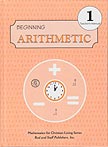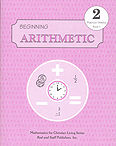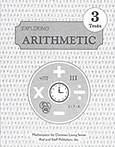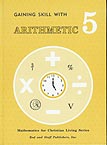Purchase these books from the
Math Textbooks at Milestone Books
Click on a course to see an overview and sample lessons.





Beginning Arithmetic is designed to start at the beginning of first grade. The 170 lessons are bound into 2 workbooks of 176 pages each, with 1 tear-out sheet for each lesson. First graders can more easily write on one sheet rather than in a thick workbook, and the tear-out pages also make checking more convenient.
No unit or chapter divisions are given. Money, measures, place value, fractions, and so forth are taught throughout the year while addition and subtraction facts are being drilled.




The 170 lessons of Grade 2 are bound in four workbooks. Unit 1 reviews addition and subtraction facts through 10, and other skills taught in Grade 1. Unit 2 teaches all the addition and subtraction factions for the 11s, 12s, and 13s, and carrying and borrowing as well. Unit 3 teaches the 14s and 15s, and Unit 4 teaches the 16s, 17s, and 18s. Continuous review is built into the lessons, and simple reading problems are practiced frequently. Speed drills are included in the workbooks. Money, time, and measures are reviewed; pounds and ounces are introduced, along with one-dollar bills. Calendars, graphs, and quarter-hour and five-minute time increments are taught.




Exploring Arithmetic has 170 lessons. It reviews addition and subtraction skills from Grades 1 and 2 and teaches multiplication and division facts through table 9 and simple two- and three-step multiplication and division. Other concepts drilled are fraction meaning, measure equivalents, money values, and telling time. Mixed computation and Roman numerals are introduced. Continuous review is built into the lessons, and simple reading problems are practiced frequently.



Progressing with Arithmetic has 170 lessons, counting tests, most being two pages long. Lesson concepts are clearly explained to the student. After reviewing the basic facts and teaching the multiplication and division facts 10's-12's, this book teaches long division, multiplying by 2-digit numbers, and checking in the four processes of computation. Reading problem skills include distance-rate-time, 2-step problems, using sketches, and identifying missing information.



Gaining Skill with Arithmetic has 170 lessons (counting tests), most being two pages long. Lesson concepts are clearly explained to the student. This book continues to review the basic facts of the four number processes. It reviews two-digit multipliers, the long division process, measures, large numbers, fractions, and decimals. Other important areas of study are the introduction of two-digit divisors, three-digit multipliers, multiplication and division with decimals and fractions, ratios, geometry, square measure, graphs, and scale drawings. Reading problems are exercised regularly.



The 170 lessons in Grade 6 include the reviews and tests. The lessons explain and illustrate new concepts, which are built on concepts taught in the previous grades. Some new concepts taught in Grade 6 include greatest common factor; decimal-fraction-percent equivalents; finding discounts, commissions, and interest; conversions between English and metric measures; finding areas of parallelograms, triangles, and circles; using a protractor; and constructing graphs.




There are 170 lessons in Mastering Mathematics.




There are 170 lessons in Applying Mathematics.
Click on a course to see an overview and sample lessons.